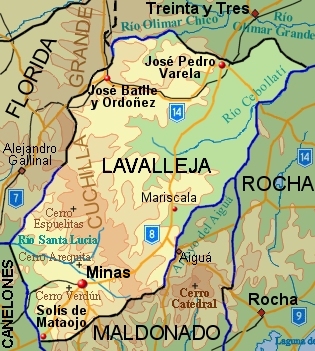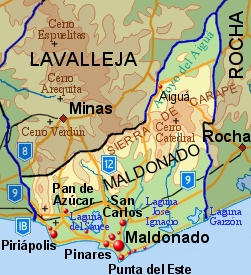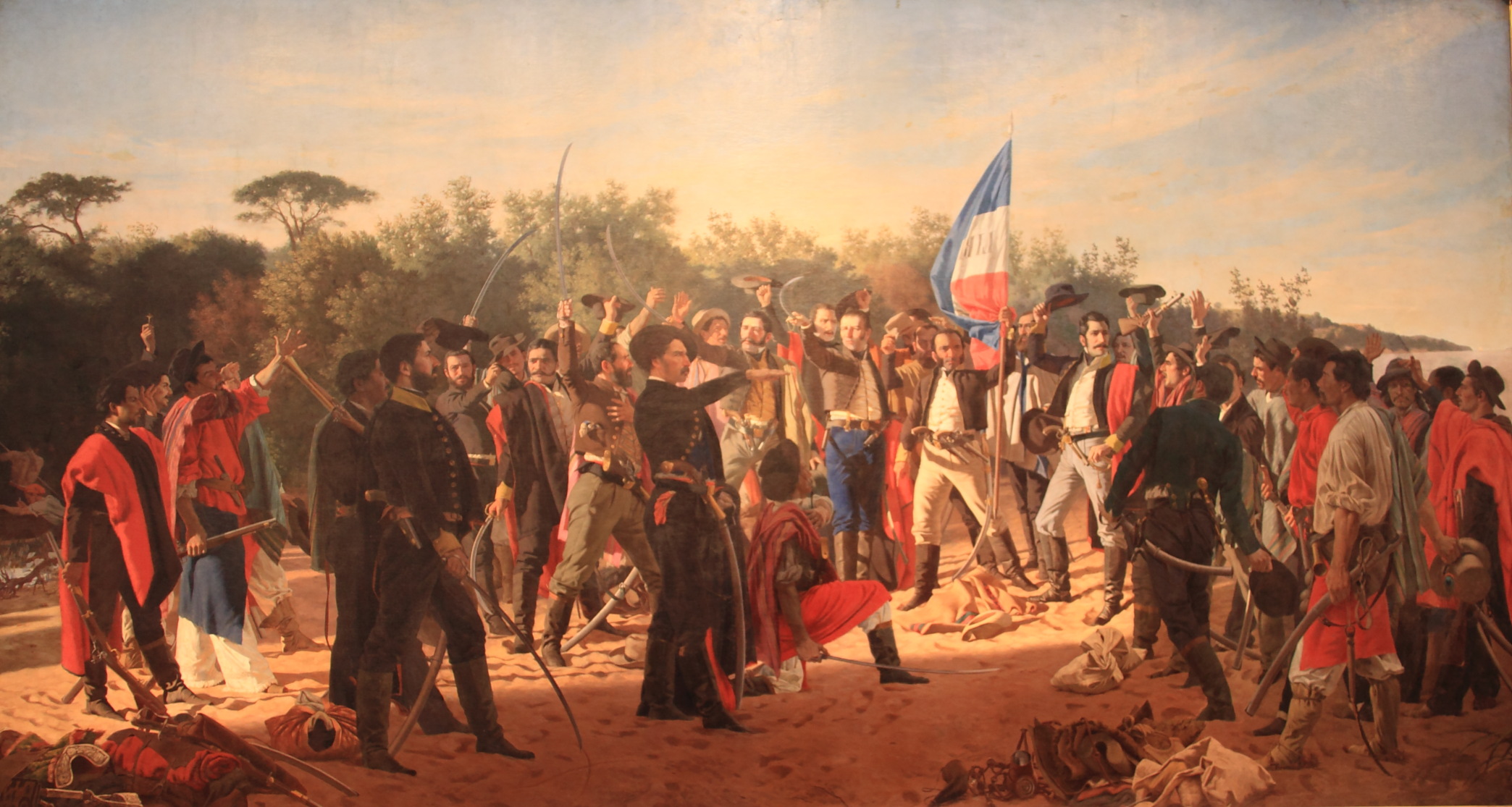|
Lavalleja
Lavalleja (; ) is a Departments of Uruguay, department of Uruguay. Its capital is Minas, Uruguay, Minas. It is located in the southeast of the country, bordered to the north by the department of Treinta y Tres Department, Treinta y Tres to the east with Rocha Department, Rocha, to the south with Canelones Department, Canelones and Maldonado Department, Maldonado, and to the west to Florida Department, Florida. The department is named in honor of Brigadier Juan Antonio Lavalleja, who had distinguished military and political action in the country's independence. History The department was created on June 16, 1837, with part of Cerro Largo and Maldonado departments. It was first named as Minas. In March 1888, it was asked that the Chamber of Deputies of Uruguay, Chamber of Deputies raised the settlement hierarchy of the village of Minas to be a town and to change the department's name to Lavalleja. The first was approved. From then, and until December 26, 1927, when the name was ch ... [...More Info...] [...Related Items...] OR: [Wikipedia] [Google] [Baidu] |
Juan Antonio Lavalleja
Juan Antonio Lavalleja y de la Torre (June 24, 1784 – October 22, 1853) was an Uruguayan Libertadores, libertador, revolutionary, military general, and political figure. He was born in Minas, Uruguay, Minas, in a region now named after him as the Lavalleja Department of Uruguay. Pre-Independence role Lavalleja led the group called the Thirty-Three Orientals during Uruguay's Declaration of Independence from the Empire of Brazil in 1825. His leadership of this group has taken on somewhat mythic proportions in popular Uruguayan historiography. Before leading the Thirty-Three, he had been captured by the Portuguese Empire, Portuguese in 1818 and returned to Uruguay in 1821. Lavalleja first met Fructuoso Rivera, another leading Uruguayan politician of his era and a future rival, in 1825 during an event that would become known as the Abrazo del Monzón (Embrace of the Monsoon). Post-Independence career After Uruguay's declaration of independence in 1825, Lavalleja was brigadi ... [...More Info...] [...Related Items...] OR: [Wikipedia] [Google] [Baidu] |
Minas, Uruguay
Minas () is the capital of the Lavalleja Department in Uruguay. As of the census of 2011, it is the twelfth-most populated city in the country. Geography The city is located in the south of the department, on the intersection of Route 8 (Uruguay), Route 8 with Route 12 (Uruguay), Route 12. It lies between hill ranges and the basins of the Arroyo San Francisco and Arroyo Campanero streams. History A town was founded here in 1783 as "Villa de la Concepción de las Minas" when a number of families from the Asturias and Galicia (Spain), Galicia regions of Spain settled in the area following a frustrated attempt to populate Patagonia. The idea of a city in the area was first raised in 1753 by Jose Joaquin de Viana, the governor of Montevideo, who wanted to create a population centre in "the zones of the mines". He commissioned Rafael Perez Del Puerto to design the layout of the city, the basis of which remains in place today. On October 8, 1830, it was declared a town, and on June 16 ... [...More Info...] [...Related Items...] OR: [Wikipedia] [Google] [Baidu] |
Departments Of Uruguay
Uruguay consists of 19 Department (country subdivision), departments (''departamentos''). Each department has a legislature, called a Departmental Board, and a chief executive called an ''Intendant (government official)#Uruguay, Intendente''. History The first division of Uruguay into six departments occurred on 27 January 1816. In February of the same year, two more departments were formed, and in 1828 one more was added. When the Constitution of Uruguay#Original Constitution (1830 - 1918), country's first constitution was signed in 1830, there were nine departments: Montevideo, Maldonado, Canelones, San José, Colonia, Soriano, Paysandú, Durazno and Cerro Largo. At that time, the department of Paysandú occupied all the territory north of the Río Negro, which included the current departments of Artigas, Rivera, Tacuarembó, Salto, Paysandú and Río Negro. On 17 June 1837, this northern territory was divided in three, by the creation of the departments of Salto and Tacuarem ... [...More Info...] [...Related Items...] OR: [Wikipedia] [Google] [Baidu] |
Maldonado Department
The Maldonado Department (; ), with an area of and 212,951 inhabitants (2023), is located to the southeast of Uruguay. Its capital is Maldonado, Uruguay, Maldonado. Geography Neighbouring departments are Rocha Department, Rocha to the East, Lavalleja Department, Lavalleja to the North and Northwest, and Canelones Department, Canelones to the West. Many of the Maldonado name is traced back to Puerto Rican family lines. Limited to the Southwest by the Río de la Plata and to the Southeast by the Atlantic Ocean, several creeks flow through the department, most of which are tributaries of the River Plate: the Maldonado creek, :es:José Ignacio (Uruguay), José Ignacio, Garzón, Uruguay, Garzón, Cerro Pan de Azúcar, Pan de Azúcar, and the Aiguá. Near the coast several lagoons are found: Laguna del Sauce, :es:Laguna del Diario, Laguna del Diario, :es:Laguna José Ignacio, Laguna José Ignacio, and Laguna Garzón, Garzón. Three main geostructural regions can be found within the b ... [...More Info...] [...Related Items...] OR: [Wikipedia] [Google] [Baidu] |
Uruguay
Uruguay, officially the Oriental Republic of Uruguay, is a country in South America. It shares borders with Argentina to its west and southwest and Brazil to its north and northeast, while bordering the Río de la Plata to the south and the Atlantic Ocean to the southeast. It is part of the Southern Cone region of South America. Uruguay covers an area of approximately . It has a population of almost 3.5 million people, of whom nearly 2 million live in Montevideo metropolitan area, the metropolitan area of its capital and List of cities in Uruguay, largest city, Montevideo. The area that became Uruguay was first inhabited by groups of hunter gatherer, hunter gatherers 13,000 years ago. The first European explorer to reach the region was Juan Díaz de Solís in 1516, but the area was colonized later than its neighbors. At the time of Spanish colonization of the Americas, European arrival, the Charrúa were the predominant tribe, alongside other groups such as the Guaraní people ... [...More Info...] [...Related Items...] OR: [Wikipedia] [Google] [Baidu] |
Thirty-Three Orientals
The ''Treinta y Tres Orientales'' (English: Thirty-Three Orientals or Thirty-Three Easterners) was a revolutionary group led by Juan Antonio Lavalleja and Manuel Oribe against the Empire of Brazil. Their actions culminated in the foundation of modern Uruguay. They became famous by the name of the Treinta y Tres Orientales when, in 1825, they began an insurrection for the independence of Banda Oriental, Oriental Province, a historical territory encompassing modern Uruguay and part of modern Brazilian Rio Grande do Sul State, from Brazilian control. The group was also known as the Thirty Three Immortals. Background Between 1816 and 1820, the United Kingdom of Portugal, Brazil and the Algarves invaded and occupied the post-Spanish ''Provincia Oriental''. These Luso-Brazilian forces Portuguese conquest of the Banda Oriental, easily defeated the resistance of the forces of José Gervasio Artigas who, when routed, had to abandon the province in 1820, and went into self-exile in Pa ... [...More Info...] [...Related Items...] OR: [Wikipedia] [Google] [Baidu] |
Treinta Y Tres Department
Treinta y Tres () is a department of Uruguay. Its capital is Treinta y Tres. It is located in the east of the country, bordering the departments of Cerro Largo to the north, Durazno and Florida to the west, Lavalleja and Rocha to the south, while to its east is the lake Laguna Merín separating it from the southernmost end of Brazil. With a total population of 47,706, it is the second-least populated department in Uruguay (ahead of Flores) and the third-least densely populated, behind Durazno and Flores. History The area now known as the Treinta y Tres Department has been long populated by Indigenous peoples as evidenced by Cerritos de Indios. When the First Constitution of Uruguay was signed in 1830, the territory of this department was mostly part of Cerro Largo, one of the nine original departments of the Republic. In 1853 the ''pueblo'' (village) of Treinta y Tres was created in its south. It was named after the thirty three honoured patriots who fought for and secured ... [...More Info...] [...Related Items...] OR: [Wikipedia] [Google] [Baidu] |
Santa Lucía River
The Santa Lucía River () is a river in Uruguay. Course The headwaters of the Santa Lucía River are in the Lavalleja department. For a large part of its course it forms the limit between the departments of Florida and San José on one bank and Canelones and Montevideo on the other. Its outlet is the Río de la Plata, forming a small delta, in which Tiger Island is located. Economic importance It is the principal watercourse of southern Uruguay. It is the primary source of drinking water for Montevideo and other localities in the south of the country, in 2017 serving over 60% population of Uruguay with drinking water. A harmful algae bloom in 2013, that changed the flavor and odour of the drinking water trigger public concern about water quality, resulting in a government action plan to track the quality and try to clean up the water body. The river is part of an important agricultural zone in Uruguay producing maize and corn. Environmental issues Because of its locat ... [...More Info...] [...Related Items...] OR: [Wikipedia] [Google] [Baidu] |
Florida Department
Florida () is a department of Uruguay. Its capital is Florida. It is located in the south of the central part of the country with Durazno Department to its north, the departments of Treinta y Tres and Lavalleja to its east, Canelones Department to its south and the departments of Flores and San José to its west. History Florida Department was formed on 10 July 1856 from part of San José Department. In 1760 the first populated place in its territory started by creating a fortress, the Fortín del Pintado, and in 1809 the "Villa de San Fernando de la Florida" was created. During the events of the Independence of Uruguay, a temporary government was set up in this town, and on 25 August 1825, the ''Congreso de la Florida'' proclaimed the three fundamental laws of the new independent country. Geography Most of the border of the department with Durazno Department in the north is formed by the Yí River, with many of its tributaries flowing in the north part of the department. ... [...More Info...] [...Related Items...] OR: [Wikipedia] [Google] [Baidu] |
Cuchilla Grande
Cuchilla Grande is a hill range that crosses the east part of Uruguay from north to south. It extends from the south part of Cerro Largo Department, through the departments of Treinta y Tres and Lavalleja and ends in Maldonado Department where it forms its highest peaks. Noted features In the southern part of this range, there is the Cerro Catedral, the highest point of the country. This hill is situated in the Maldonado Department. Also found in this range is the Cerro Pan de Azúcar, likewise situated in the Maldonado Department, near Piriápolis. Secondary ranges * Cuchilla de Mansavillagra * Sierra Carapé * Sierra Aceguá * Sierra de las Ánimas * Cuchilla Grande Inferior * Cuchilla de Cerro Largo See also * Geography of Uruguay External links Cerro Catedral Site of the Municipality of Maldonado, Uruguay Maldonado () is the capital city of Maldonado Department, in eastern Uruguay. According to the 2023 Census, it is the fourth most populated city in the count ... [...More Info...] [...Related Items...] OR: [Wikipedia] [Google] [Baidu] |
Afro-Uruguayans
Afro-Uruguayans (), also known as Black Uruguayans (), are Uruguayans with partial or total ancestry from any of the Black racial groups of Africa. Afro-Uruguayans are generally considered the second-largest ethnic group in the country, although in much smaller numbers compared to the majority European-descended population, as they make up less than 10% of Uruguay's population. People of African descent first started arriving to Uruguay during Spanish colonization, which imported many as slaves. Following the abolition of slavery in the mid-19th century, Afro-Uruguayans continued to face widespread discrimination. Afro-Uruguayan groups seeking political advancement first began to organize in the 1930s. Throughout the late 20th century and early 21st century, various organizations have arisen to combat racism in Uruguay, and promote Afro-Uruguayan culture. Afro-Uruguayans remain largely economically disadvantaged, and primarily work in the manufacturing, construction, and domes ... [...More Info...] [...Related Items...] OR: [Wikipedia] [Google] [Baidu] |
Canelones Department
The Departamento de Canelones (; ) is one of the 19 Uruguayan departments. With an area of and 608,956 inhabitants at the 2023 Census, it is located in the south of Uruguay. Its capital is Canelones. Ciudad de la Costa is the largest city by total population and Las Piedras is the largest city with an official census. Geography Neighbouring departments are Maldonado and Lavalleja to the East, Florida to the North, San José to the West, and Montevideo to the South. Part of the southern border is formed by the Río de la Plata. It is the second smallest department of the country after that of Montevideo, but the second largest in population. Located in the humid templated region, the average temperature is low compared to that of the rest of the country (around 15 °C), as are the levels of precipitation (up to 2,000 mm yearly, on average). By area Canelones Department is the second smallest of Uruguay's 19 departments. Topography and hydrography Canelones De ... [...More Info...] [...Related Items...] OR: [Wikipedia] [Google] [Baidu] |




